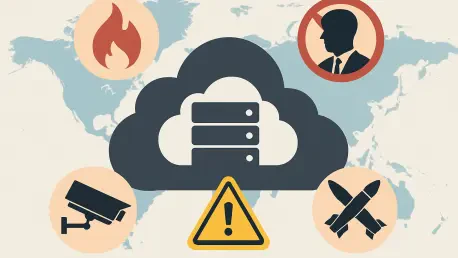The increasing reliance on cloud services in the business landscape brings new vulnerabilities, especially as geopolitical tensions influence service availability and confidentiality. The disruption of services can have profound effects on operational capabilities and business continuity. A notable incident involving Microsoft and Nayara Energy serves as a stark illustration, where geopolitical decisions compelled a suspension of services without prior notification. This scenario reveals the necessity for businesses to address the potential risks of sudden service interruptions by cloud providers, which can stem from external pressures like government sanctions.
Understanding the Implication of Service Interruptions
Geopolitical Pressures and Cloud Services
The tech industry is witnessing an unprecedented intersection of geopolitics and technology, with service suspensions often driven by political decisions. The European Union’s sanctions directed at Russia forced Microsoft to halt its services to India-based Nayara Energy, illustrating the burdens companies may face due to such external factors. These service disruptions, often unaccompanied by advance warnings or explanations, highlight the potential hazards businesses encounter when geopolitical dynamics affect their core operations. For companies dependent on global vendors, an unexpected service withdrawal can lead to significant operational stoppages, challenging their ability to remain agile and responsive.
The lack of forewarning and transparent communication poses a critical challenge, complicating a company’s ability to plan for potential service disruptions. This instability necessitates a deep reassessment of business strategies and dependency on international technology providers. The reality is stark: any organization, regardless of size or sector, can find itself vulnerable when geopolitical events dictate service delivery terms. Companies need to incorporate geopolitical awareness into their risk management strategies, assessing how political decisions in different regions might affect their access to essential digital services.
Contracts and Control Over Digital Assets
Cloud service agreements often lay bare the power imbalances between vendors and clients, especially in contract terms that allow abrupt terminations. Microsoft’s decision to sever ties with Nayara Energy, despite pre-payment for services, underscores the vulnerability many enterprises face concerning control over their data and digital resources. This incident raises vital questions about the extent of autonomy a company owns over its operational assets stored in the cloud. Such an imbalance necessitates a reevaluation of contract terms, urging companies to seek clearer clauses that avoid unexpected disruptions.
Businesses should consider advocating for contract provisions that stipulate clear procedures during geopolitical tensions or other extraordinary circumstances. Legal experts highlight the complexity of crafting agreements that safeguard against global tensions, ensuring that businesses retain a measure of control over their data and applications. It’s imperative for companies to demand clauses providing advance notice and a commitment to maintaining services unless a straightforward legal requirement dictates otherwise. While contracts that prioritize refunds might lessen financial burdens, they fall short of addressing the more critical need to maintain operational continuity.
Crafting a Robust Business Continuity Plan
Redundancy and Diversification of Services
The capability for a company to continue operations amidst cloud service disruptions hinges on strategic redundancy and diversification. Exploring collaborations with multiple service providers, including regional and local options, can alleviate dependencies on a single vendor. This not only reinforces data security but also ensures that operational applications have alternative pathways accessible when a primary vendor’s services become unavailable. Although duplicating systems is intricate and resource-intensive, it is an imperative step toward guaranteeing uninterrupted access to business-critical data and applications.
Incorporating open-source platforms into the enterprise architecture presents another viable alternative. By diversifying digital infrastructure across various vendors and platforms, businesses are positioned more favorably to counteract disruptions. This also ensures a broader spectrum of resources for data recovery and manual operations. Enterprises should develop comprehensive continuity plans that anticipate service removal scenarios, updating regularly according to evolving technological and geopolitical landscapes. The key lies in constructing a resilient operational framework that integrates redundancy as an essential component of robust risk management.
Preparing for Future Disruptions
Strategically addressing the potential shocks from service cessation requires heightened awareness and proactive planning. Business leaders are urged to integrate novel disaster recovery frameworks—a strategy that acknowledges the rapid interconnectivity and technological dependence inherent in present-day enterprises. By adopting innovative solutions that include duplicating critical systems and exploring alternate solutions, companies can mitigate the effects of sudden service losses.
An effective business continuity plan should be dynamic, encompassing various potential scenarios, including those stemming from unexpected geopolitical developments. The abrupt nature of service disruptions calls for periodic simulated exercises and revisions of disaster recovery measures, ensuring that enterprises remain prepared for myriad operational challenges. More than a disruption narrative, this demands a continuous dialogue around enhancing resilience and rethinking conventional risk assessments beyond conventional service agreements.
Assessing Future Implications and Strategies
Beyond Contracts: Building Resilient Enterprises
The Microsoft-Nayara Energy incident illustrates a broader theme of geopolitical-economic interactions affecting technology service provision. Organizations must now weigh geopolitical considerations alongside traditional business relationships in their strategic planning. By evaluating the risks associated with third-party providers and implementing rigorous due diligence, enterprises can establish protective measures that guard against unexpected service alienations.
Enhancing risk management practices involves diversified vendor engagement and reassessing the terms of technology partnerships. Strategic foresight necessitates questioning assumptions about the permanence and reliability of current digital infrastructures. This shift urges companies to explore collaborations with a wider array of service providers, potentially including regional entities, to mitigate dependency on singular, internationally-based vendors. Crafting a more balanced vendor portfolio may offer resilience against geopolitical and economic fluctuations.
The Road to Greater Data Autonomy
The growing dependence on cloud services in today’s business environment introduces significant vulnerabilities, particularly as geopolitical tensions impact service reliability and confidentiality. Interruptions in service can severely affect a company’s operational capabilities and overall business continuity. A pertinent example involves a situation with Microsoft and Nayara Energy, where geopolitical pressures led to an abrupt halt in services without prior notice. This case highlights the critical need for businesses to prepare for sudden service disruptions by cloud providers, often triggered by external factors like government sanctions. Organizations must develop robust strategies to mitigate these risks, including diversifying service providers and implementing effective contingency plans. As geopolitical landscapes constantly shift, businesses must stay vigilant, actively assessing the geopolitical climate and its potential impacts on cloud service availability to ensure long-term resilience and reliability in their operations.









